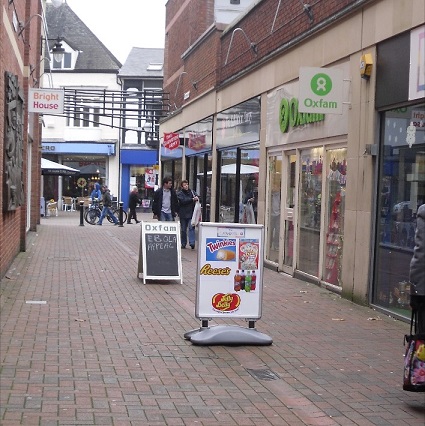Tactile paving is often provided to provide information to pedestrians with poor vision of potential hazards ahead. There are various patterns of paving warning of different types of hazard as can be seen on this accompanying video (please ensure your volume is on).
Getting around
Having arrived at your destination, you need to get around to all the places you want to visit.
Kerbs are an issue for wheeled vehicles and, indeed, for anyone unsteady on their feet or with poor vision. Kerbs normally separate pedestrians from road traffic but can appear unintentionally between different surfaces. Drop kerbs are necessary for wheelchair users and mobility scooters to navigate across roads and so are vital at normal crossing places especially pedestrian crossings.
Towns with a High St giving access to lots of shops will often institute pedestrian precincts around those shops. This has advantages and disadvantages. It ensures pedestrians' safety when shopping but it can distance the carparks from where car users need to go. In some instances the pedestrian area is actually shared space to allow for deliveries to the shops and to allow disabled people closer parking.
Businesses will use whatever methods they can to attract custom and increase trade. This may include use of A boards to advertise their shop. Cafes, in particular, may put tables and chairs outside their premises, with the council’s permission. Other traders may put merchandise directly onto the footpath outside the shop. County council policy places restrictions on the use of the footpaths but this policy is often ignored and not strictly enforced.
This all adds colour to a town and gives a continental feel to the place but can cause problems to people trying to get around. Those with mobility issues and poor vision will experience obstructions and trip hazards. Guide dogs tend to keep to shop frontages and so will not have an unrestricted route. Parents with buggies and, particularly, double pushchairs have difficulty navigating a route through and often the hazards occur all together making things worse.
Towns will try to make their High Streets attractive to visitors by paving the shopping areas and adding street furniture, like ornamental posts, trees, cycle racks and benches. They may introduce different types and styles of paving, which can cause uneven surfaces. If a paved surface has been repaired with tarmac, this will sink with usage leading to uneven levels, which are trip hazards, particularly for the visually impaired, and are unsightly.




